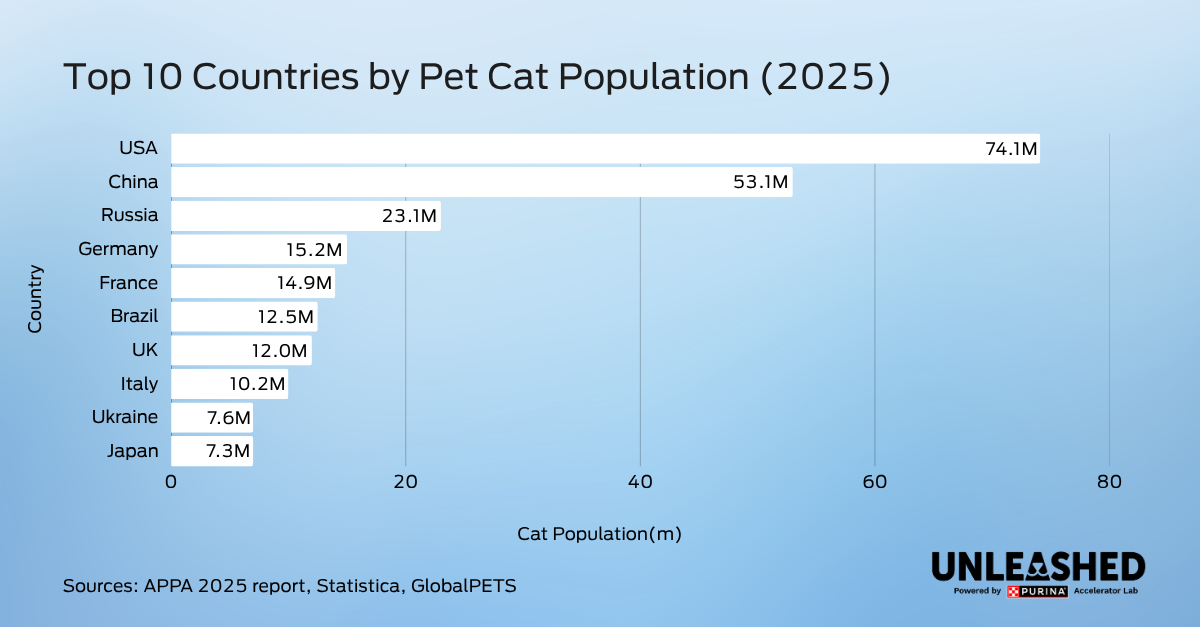
When the average person thinks of a ‘pet’, their mind likely turns to whatever critter they have at home (or the one their annoying neighbour has). Rabbit. Goldfish. Cat. Parakeet.
But when the pet care industry thinks ‘pet’, they really mean ‘dog’.
Cat ownership is rising globally with a rabid base of cat parents ready to move mountains for their cats. And yet, innovation in the cat space trails far behind that of dogs.
Investing in cat tech isn’t just a good business move; it leads to fewer lost cats, better veterinary care, and ultimately, more feline lives saved.
Today, we dive deep into the world of cats. Why, historically, they’ve been overlooked in pet care. The newest data about the modern cat parent. The tech innovators determined to support them. And the untapped and underserved areas of cat care that could present a billion-dollar opportunity for those brave enough to try.
The ‘small dog’ problem
Cats are not small dogs. This is an intuitive statement, and yet it somehow seems radical to say out loud.
Dogs have been humans’ best friend for over 10,000 years. Whereas cats are barely domesticated companions that decided to cohabitate with us.
“I think that's primarily the key misunderstanding that created this systemic underinvestment across product development, brand strategy and education”, said Kristin Wuhrman, Founder and CXO at CatsOnly Veterinary Services.
That apparent nonchalance and lack of ‘voice’ has led to a pet-care landscape that favours canine over feline. Many cat products have been smaller-scale dog products. Even in areas where cats and dogs are extremely different, like nutrition and pharmaceuticals.
And let's be honest. Historically, there's been more money in catering to dog parents, too.
Dog owners have higher household incomes; they are only too happy to spend more of their money on their dogs.
Plus, dog parents know their dogs’ habits extremely well. Kibble vs raw. At-home grooming vs professionals. Dog walking vs daily runs. The market is well defined and easy to penetrate.
But cat parenthood is still evolving and growing rapidly. The new generation of cat parents is still finding its feet when it comes to cat care. So, the time is now for pet care startups to onboard this soaring group of passionate pet owners.
Don’t believe in the cat boom? Let’s look at the numbers.
The cat boom
Despite our longstanding adoration for dogs, cat ownership has been rising globally over the past few years. Not only are there more cat owners, but there are also more cats per household.

The U.S. leads with over 70 million cats across 49 million households, but Europe as a whole now has more cats than dogs. The rise is global and it’s accelerating.
Kristin Wuhrman, Founder and CXO at CatsOnly Veterinary Services said, “We saw a 23% cat ownership growth just last year, and cat-only households are now at 44%.”
But there are two recent demographic trends that could be game changing for cat tech pioneers.
New cat dads
A recent Global Pet Survey revealed that 52% of the cat-owning respondents were male, and 48% were female. This is particularly significant among GenZ and millennials.
So while the ‘single cat lady’ stereotype is firmly in place, it seems the tide is changing.
Is this significant? Some think so!
Susan Groeneveld, CEO and Founder of Sylvester.ai said “And that is going to be the best thing that's ever happened for cats, candidly, because of the gender wage disparity; as men have more disposable income”.
There’s also decent data to suggest that men are slightly more willing to adopt new technology than women, though this gap is likely to close in the coming years due to the new generation of users.
Generation cat
The most significant change among cat ownership has been the sharp rise in millennial and GenZ owners. This makes sense. GenZ and millennials are in their mid-twenties to mid-forties. Many are opting for pet parenthood instead of real parenthood, citing finances as a primary factor in that decision.
People are also living in smaller homes, which are traditionally seen as more cat-friendly.
With all of these factors in mind, it’s clear why Ali Ganjavian, Co-Founder of Moggie, said that cats are “the pet of the future”. And yet, the pet tech space has been slow to catch up to this boom. Let’s talk about the early innovators in the cat tech realm.

The innovators changing the game
I recently interviewed a selection of cat tech founders to learn more about the way they are bettering the lives of cats everywhere.
Health & wellbeing
The primary concern of most cat owners is the health and wellbeing of their furry friend. And yet cats don’t make it easy for us.
Ali Ganjavian, Co-Founder of Moggie said, “Cats are really incredibly good at two things. One of them is being autonomous, and the other one is hiding their illnesses”.
So, tech founders have been approaching the feline’s lack of ‘voice’ in multiple ways to detect health changes before it’s too late.
Wearable tech, like the Moggie wellbeing tracker, tells owners how much their cat is resting, grooming and playing.
Unleashed by Purina alumni, Sylvester.ai, uses cutting-edge technology to detect pain on a cat’s face using their own labelling model of visual indicators after studying all of the multiple validated pain scales with veterinary advisors.
“Feline specialists labelled the first data sets of images of cats in pain and without pain, clearly differentiated. And when we ran that first data set through our ML, there was 96% accuracy, which was incredible for the first iteration. Since then, we have added 1000's of more pictures and videos from medicalised cats and continue to harden our tech", said Susan Groeneveld, CEO and Founder of Sylvester.ai.
Purina’s own Petivity smart devices combine health monitoring devices like smart litter boxes and an online assistant with microbiome analysis kits to create a 360-degree picture of a cat’s health.
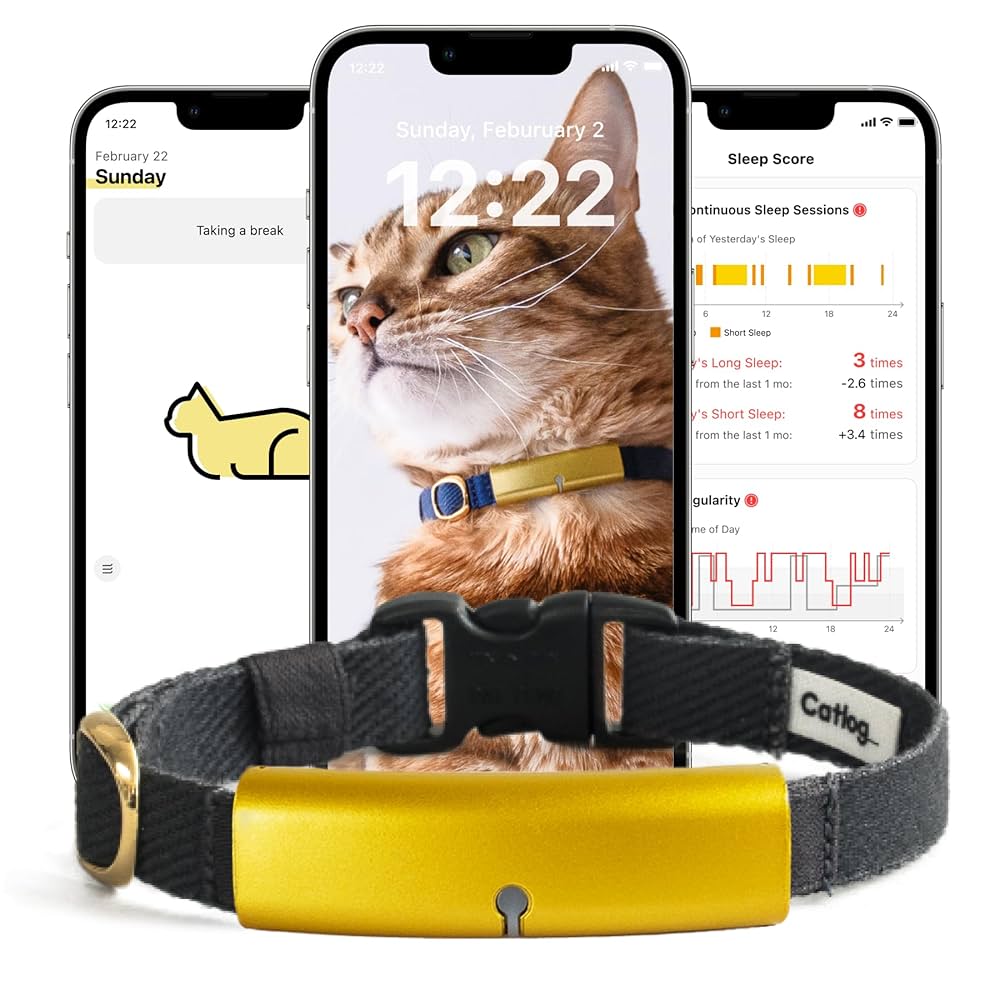
Japanese startup, RABO,Inc., created the Catlog system with a wearable health tracker and a litter box board. These can be used separately or together to build a picture of your cat’s daily habits.
However, it’s a bit misleading to suggest that only health trackers and pain-detecting tech are focused on ‘health and wellbeing’. All cat tech inventions approach this question of wellbeing and behaviour-change detection in different ways.
Every piece of data, from changes in litter box use to feeding habits, can inform a cat parent about their cat’s health.
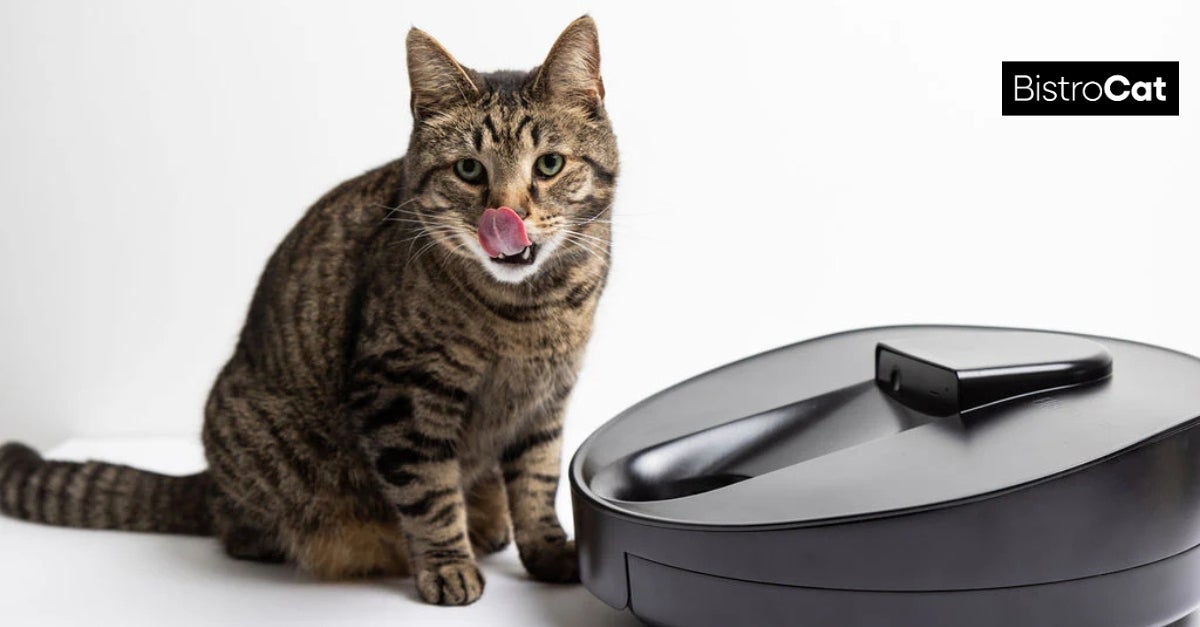
Nutrition & feeding
We all know the importance of nutrition for any pet’s health and lifespan, but it’s slightly more complex for cats. The issue? Water. If you have a cat that drinks faithfully from a bowl, you’re one of the lucky ones.
Amanda Campion, Clinical Cat Behaviourist at Kittysitty, told me she uses a smart water fountain at home which measures her cat’s water consumption. That’s one solution that startups like PetLibro are tackling. However, most cats will derive their water from wet cat food.
And doing what’s best for your cat is not always the easiest path for the pet parent.
As Cecelia “Cece” Carrera, Founder and CEO of BistroCat said, “Feeding wet food is a messy and inconvenient process. Opening traditional cans or tearing pouches can cause juices to splatter on you. You also have to physically be home to do it. It's just a lot of problems for pet parents”.
Autofeeding solutions like BistroCat and Unleashed by Purina alumni, SmartPetCare, are making feeding wet cat food a seamless process.
By tracking how much and how fast the cat is eating, the owner can also gain key insights into the cat’s wellbeing.
So it’s easy to see why the market size of autofeeders is expected to grow to $13 Billion by 2032.
One of the biggest hurdles for autofeeders is ensuring that both cat and cat parent acclimatise to the product. Because cats are picky and we cat parents know it!
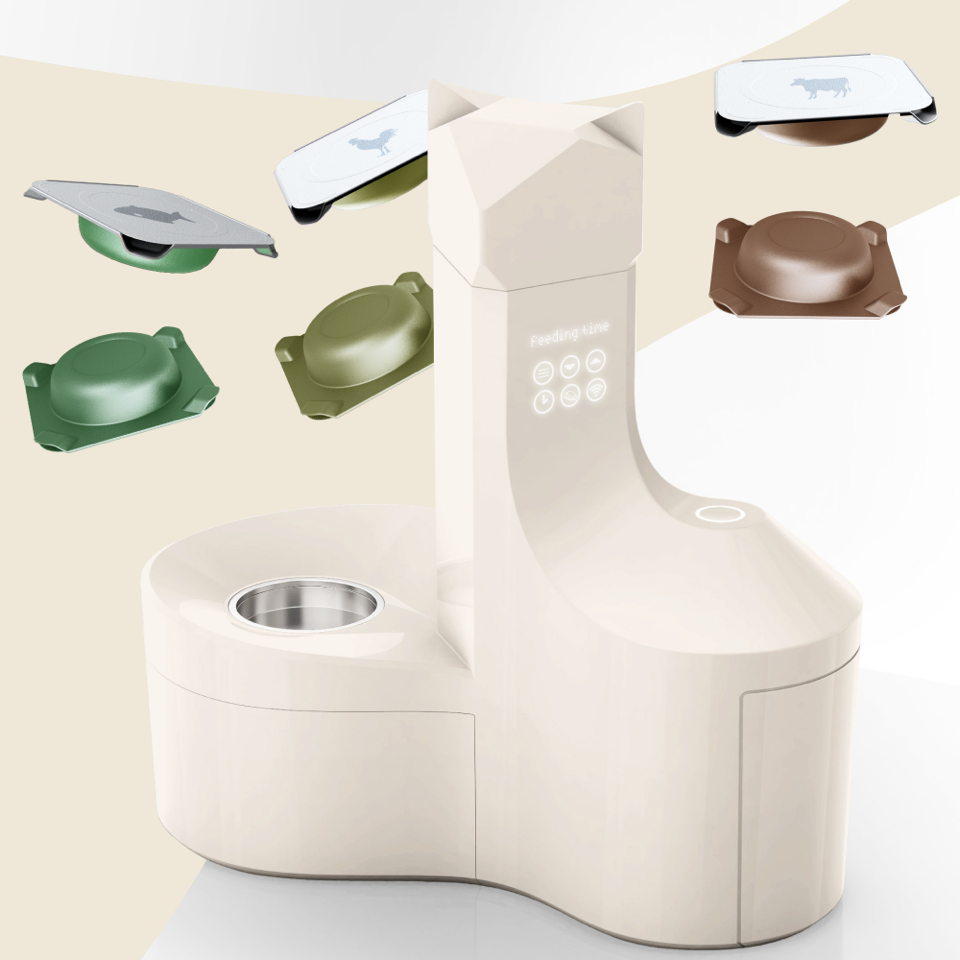
Frank Carlson, CEO of SmartPetCare, said, “We realised after our tests that people would really like a trial period to find out if the cat likes the food, if the cat accepts the system and if it fits into the cat owner’s lifestyle. We’re seriously considering offering a trial period as most of the cat parents who tried the iKitty used it more than they expected”.
During SmartPetCare’s 20-week Unleashed by Purina acceleration programme in 2025, they tested a number of cat households who adopted the system with no issues. However, there are ways startups can improve adoption.
Doron Wolfberg, Founder of Cats.com, mentioned how it’s essential for startups to create an “education that cat parents need on how to get their cat accustomed to the new product”.
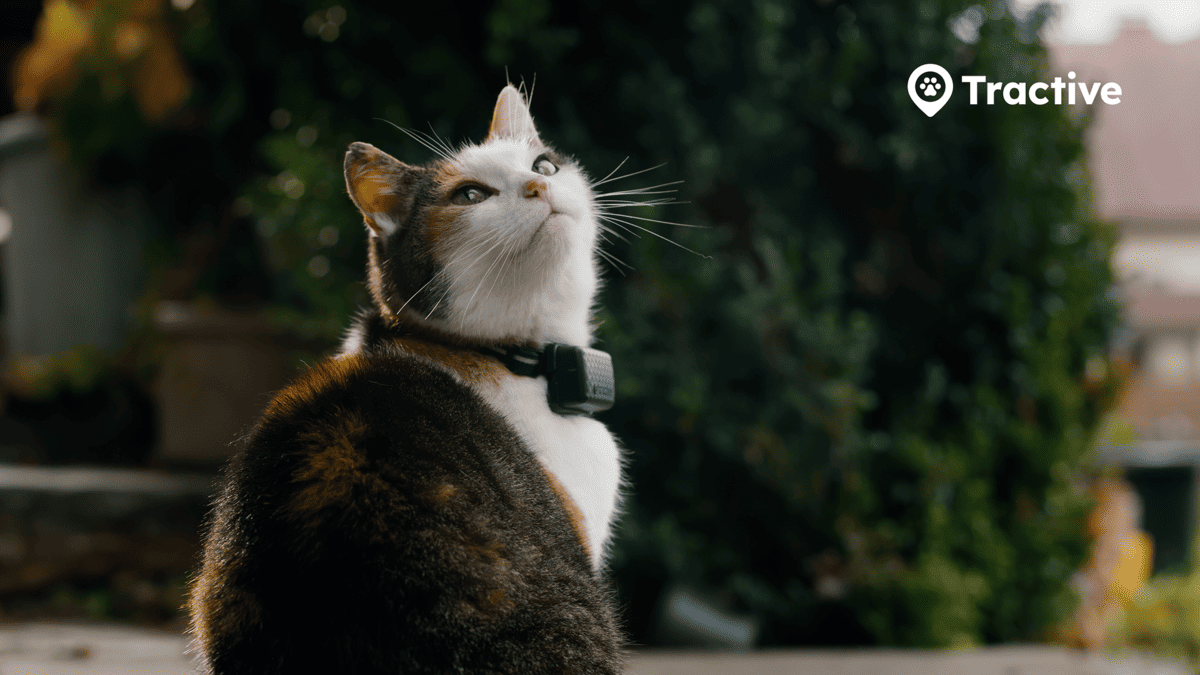
Tracking & tracing
Tracking tech is such a good fit for cats. Studies show that although the rate of pet loss is about the same between dogs and cats, dogs are found at a much higher rate than cats.
So it didn’t surprise me to learn that cat owners were using dog-first tracking devices to locate their cats.
Felix Robinson, Founder and CEO of Pet Trust UK, said, “When we first launched, we found that over a third of our tags were going to cats. That’s when I realised, cat or dog, it's still a part of your family, and the sooner the audience and the industry recognises that, the more equal it will become”.
Pet Trust UK combines a centralised database with digital tags to ensure owners can find their pets. They also have a tag-free option by registering a cat’s microchip number on the database.
Wearable tech giant Tractive launched their Cat Mini device in 2022. This was a purpose-built upgrade from the previous cat device, which was admittedly a small dog device.
The device is now used by hundreds of thousands of cats, and Andrew Bleiman, Executive Vice President of Tractive, North American Division, mentioned how cat owners use their Tractive very differently to dog owners.
He said, “The cat owner is a lot more curious about where their cat has been. So, location history and heat maps are very popular features with cat owners - more so than dog owners”.
It goes to show how purpose-built tech for cats and their owners can give greater insights into how best to serve them.
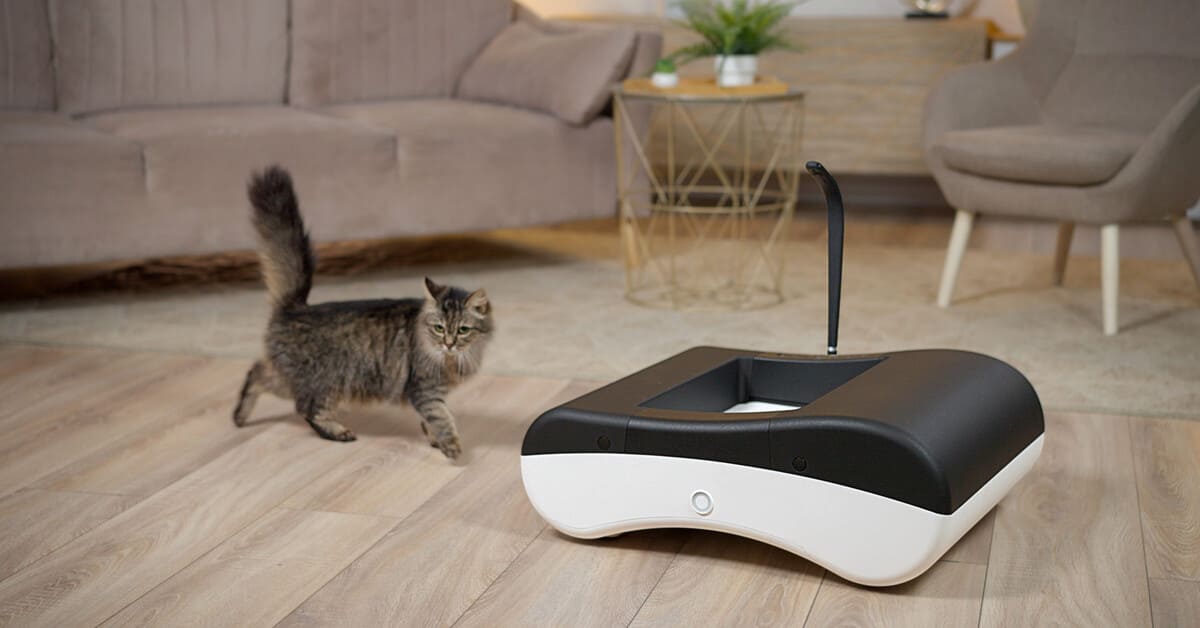
Waste management & analysis
The litter box has long been the cat parent’s primary view into a cat’s health.
Doron Wolfberg, Founder of Cats.com told me the heartbreaking story of almost losing a cat to kidney stones. “My cat had a urinary blockage a few years ago, and it was a life-threatening situation. If I had waited another hour before I took him to the vet, it could have done permanent damage to his lungs”.
So no one can deny the power of the box.
That said, cleaning out the litter box is often a cat parent’s worst chore, leading to bad habits like not cleaning it enough or using irritating chemical litters to reduce smell.
Enter the automatic litter tray or ‘litterbot’.
From autoflushing tech, like the Cat Genie, to self-cleaning systems, like The Litter-Robot by Whisker, pet parents are spoilt for choice.
RABO,Inc. takes an integrated approach with the wearable health tracker and litterbox board working together to build a portrait of the cat’s general wellbeing.
“Catlog combines a collar-shaped device (Catlog) with a board-shaped device placed under the litter box (Catlog Board) to track a cat's behavior 24/7. This enables early detection of even small changes, supporting owners in taking appropriate actions”, said Yukiko Iyo, Founder/President & CEO of Rabo,Inc.
I also spoke to Tamara Savchenko, Co-founder of PetyPot, who has created a litter-free, self-cleaning solution.
She said, “I have a cat that was very obsessive with litter. We took him to the vet and other specialists. He was totally healthy, but had a habit of digging out all of the litter and doing his business on the plastic base of the litter tray. So I decided to offer my cat a litter-free box”.
PetyPot will be piloting an AI-powered health analysis feature with their official launch in late 2025, noting the value of the box in health monitoring.
And this is the crux of it. The health tracking power of an automated litter tray cannot go unnoticed. But slow integration and cat-first design is paramount.
“Not every cat will like a litter bot. So if cat parents are going to use a litter bot, I'd always advise that they use it in tandem with other styles of tray, as well as in the home environment,” said Amanda Campion, Clinical Cat Behaviourist at Kittysitty.
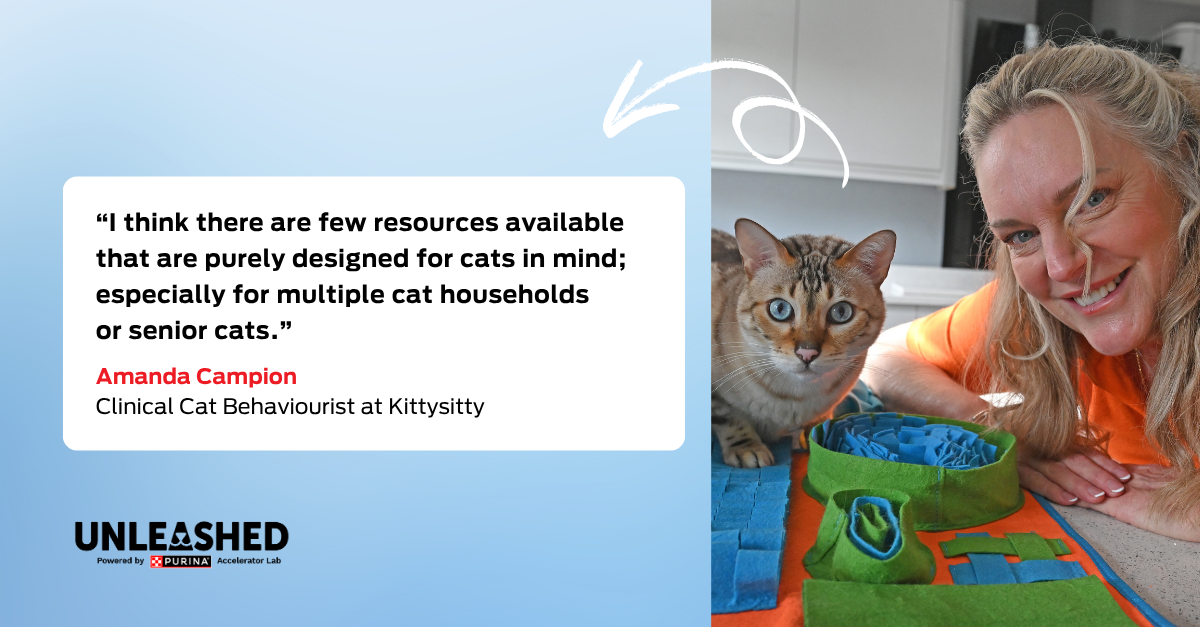
The opportunity for cat-first startups
As we’ve seen, cat tech startups are covering multiple aspects of the feline life to help our cats live happier, healthier, longer lives. And yet, every person I interviewed for this article mentioned that there was so much more that could be done in the cat space. Allow me to elaborate:
Vet collaboration
With trackers like Moggie or smart litter tech like the Catlog board, we can learn all kinds of insights about our cat. But what does it all mean? This is where vets come in.
Kristin Wuhrman, Founder and CXO at CatsOnly Veterinary Services mentioned that only around 30% of cats in the US went to the vet in 2024. “If we were able to close the medicalisation gap, it’s a $20 Billion opportunity for the veterinary industry.”
Startups are tackling this care gap with direct veterinary partnerships. Unleashed by Purina alumni, Sylvester.ai, have integrated with the AI-powered veterinary co-pilot, CoVet that serves 8,000+ users across six continents.
Other startups believe that putting the data in the hands of the cat owner in plain English will trigger more vet visits and collaboration.
Cecelia “Cece” Carrera, Founder and CEO of BistroCat said, “If we have a way to track their cat's feeding behaviours, which is one of the earliest indications of a health problem, then we can send out health alerts and data right to the user's phone through our app. We can now improve diagnostic times during a vet visit and the veterinarians have more data to build an actual comprehensive care management plan”.
Enrichment
Learning how to play with my cat has been one of the greatest challenges of our life together, and I’m not alone! The videos featuring play as a core tenet of cat care are some of the highest viewed videos on the Cats.com YouTube channel with over 260K subscribers.
Couldn’t tech help us out here?
“There are very few products that are on the market specifically for cats that tap into that predatory behaviour of a cat. Products that can incorporate sensory experience and olfactory senses”, said Amanda Campion, Clinical Cat Behaviourist at Kittysitty.
Dogs are well covered in this area by virtue of going outside for daily walks. But until safe walking spaces for cats become a staple, an enrichment system or safe catio product is on my wishlist.
Senior cats
There are over 16 million senior cat owning households in the US, which equates to 52% of the cat owning population. Furthermore, the CATalyst Council reported that mature cats (7+) were least likely to visit the vet. So there’s a clear market opportunity for tech that serves ageing cats.
This could come in the form of ergonomic design: specified health tracking for seniors or tech that could assist a cat in their daily routines. A litter bot specifically for the mobility issues senior cats face would be fantastic.
Multi-cat households
They say that two cats are better than one. But the data shows that cat households are growing far beyond two!
The American Pet Products Association (APPA) 2025 report stated that households with three or more cats increased by 36% from 2018 to 2024.
This increase is a particular bugbear for automatic litter devices and autofeeders, as cats often share these devices. Therefore, the data on how much a cat is eating or their toilet habits may be skewed by another cat.
RABO,Inc’s Catlog Litter Board tackles this by identifying each cat by weight. Smart collars like Tractive and Moggie can be given to each pet and tracked on the same app.
It’s fair to say that multi-cat households are slowly becoming the norm, so innovators need to bear in mind how multiple cats may interact with their product or service.
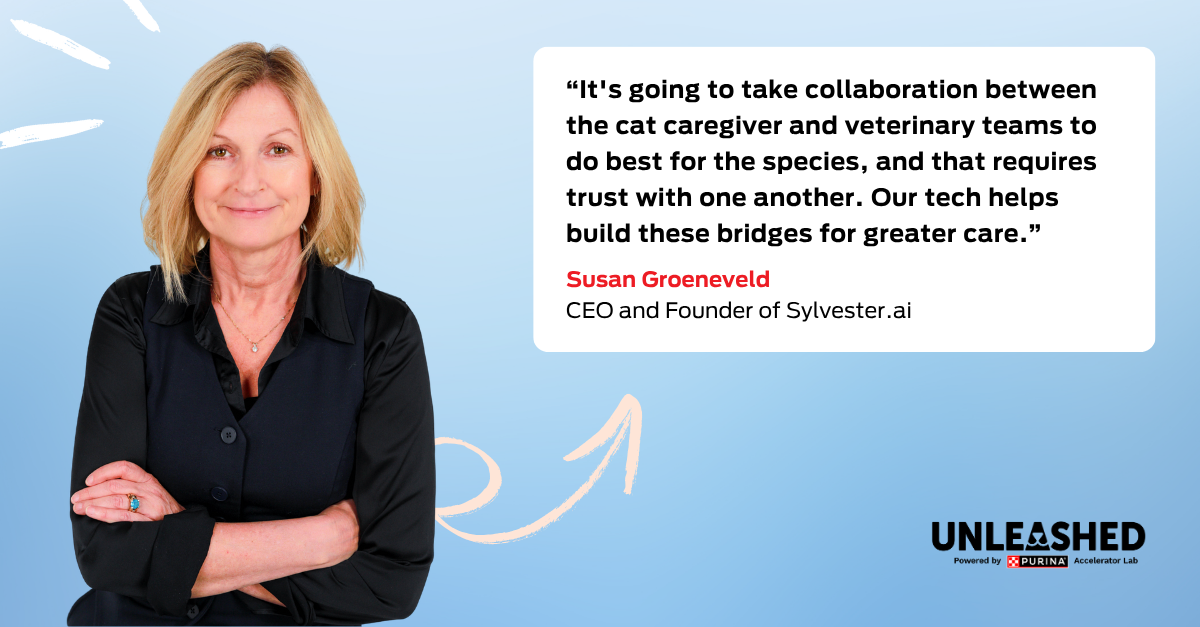
What’s next for cat tech?
The cat tech space is more than just a billion-dollar opportunity. It’s an untapped market that is ripe for innovation and growth. These are the takeaways that continue to crop up when it comes to cats and tech.
Cat parents are engaged
Whether it’s trying to decode small behaviour changes with Moggie, or finally uncovering their cat’s secret second family by monitoring their location history with Tractive, cat parents want to know far more about their cats than dog parents do.
Why? Simple. Cats don’t have a voice. Dogs are brilliant human linguists, communicating each and every emotion with surprising depth and nuance.
But cats? They remain an enigma. These tech tools provide a window into a cat’s life that we’ve never seen before.
Kristin Wuhrman, Founder and CXO at CatsOnly Veterinary Services said, “Cat parents tend to be introverted and very research-driven, and they want the very best for their cat’s emotional health. And so by not just understanding the cat's needs, but the evolving pet parents' needs, is going to be critical in product innovation”.
A feline future is a collaborative one
I asked every interviewee for this article what cat tech item they’d like to see in the world.
Tamara Savchenko, Co-Founder of PetyPot said, “If I could invent something, it would be an ecosystem of connected devices for cats that can work together. For example, a smart litterbox like PetyPot, a smart feeder, a smart water fountain and even a modular enrichment system”.
The founders of SmartPetCare, Moggie, Tractive, Slyvester.ai, and BistroCat all agreed with this statement.
It hits at a fundamental truth about cats and the tools that support them—there isn’t a singular tool to rule them all.
Instead, collaboration between startups’ systems, vets and cat parents is the ideal solution for improving cat lives.
Is it idealistic to believe that startups may share data and craft integrations for cat owners? Perhaps. But as we’ve seen in this article, it’s a combination of tech that can give us life-changing information about our cats.
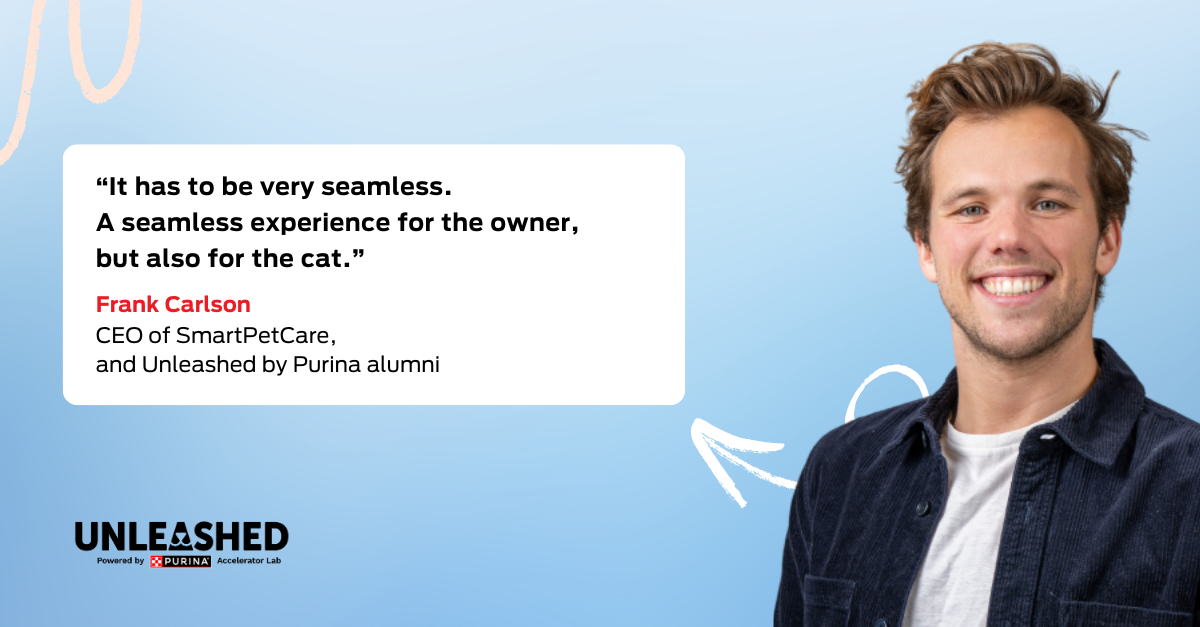
Frictionless solutions are the way forward
Throughout the research of this article, I had the pleasure of learning about some of the best advancements in cat technology today. And yet, admittedly, I only use one piece of cat tech at home—an autofeeder.
Puzzling, right? I’m the target demographic: a millennial woman living in an urban space with a single cat. I take my cat to the vet twice a year and am borderline obsessed with his wellbeing.
And, above all, I am a pet tech writer. I should be the poster child for every cat gadget and software.
The answer came from the CEO of SmartPetCare, and Unleashed by Purina alumni, Frank Carlson, “It has to be very seamless. A seamless experience for the owner, but also for the cat.”
And it’s not just cat owner behaviour that is tough to shift. It’s the cat’s behaviour, too.
Doron Wolfberg, Founder of Cats.com said “The trickiest part when introducing a new cat product is how the cat is going to adopt it. Whether it's a new food, a new litter box, or a new toy, is the cat going to enjoy using it?”
Behaviour is complex to change. To encourage change, as most habit changers know, the behaviour must be as frictionless as possible.
Whether that’s adapting the ergonomic design of an autofeeder to reduce whisker fatigue, or making a smart collar as weightless as possible, the first cat tech unicorn will be one that truly understands cat and cat parent behaviour.
The future of cat tech isn’t about treating cats like dogs, but fully embracing the quirkiness of cats. And we, the cat-loving public, are on the edge of our seats to see what cat care innovation is coming next.
Written by Olivia De Santos, Pet Tech Writer @ Unleashed by Purina